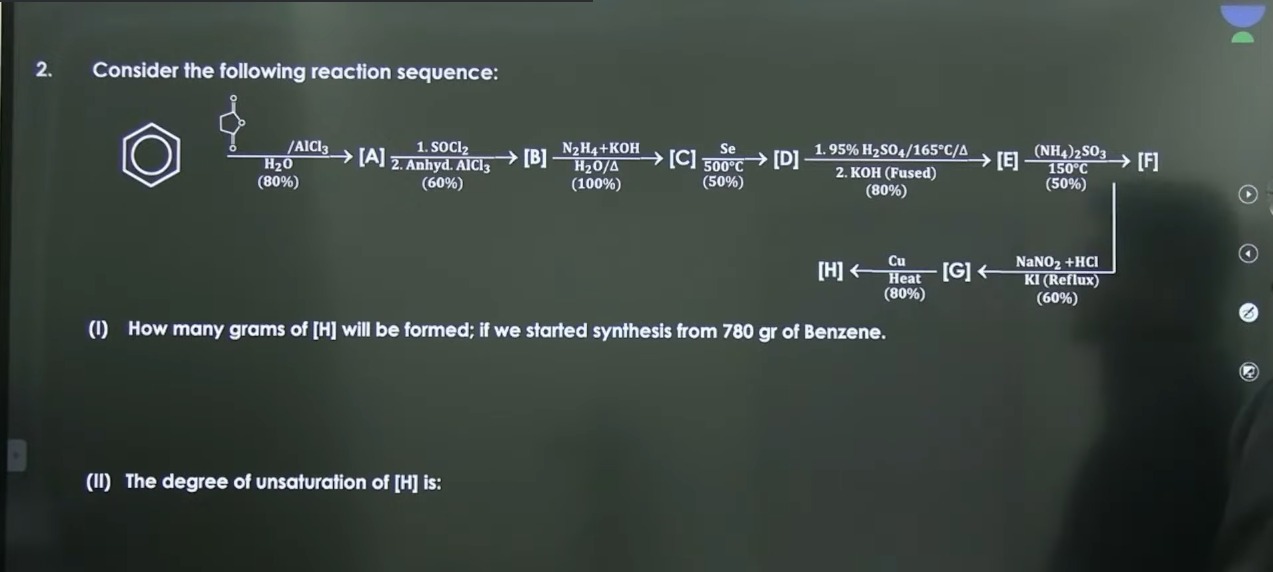Question
Question: Consider the following reaction sequence: [Image of reaction sequence is assumed here] (I) How man...
Consider the following reaction sequence:
[Image of reaction sequence is assumed here]
(I) How many grams of [H] will be formed; if we started synthesis from 780 gr of Benzene.
(II) The degree of unsaturation of [H] is:

I) 58.5216 g, II) 14
Solution
The problem involves a multi-step organic synthesis sequence, requiring the identification of intermediate products [A] to [G] and the final product [H]. Subsequently, we need to calculate the mass of [H] formed and its degree of unsaturation.
Part (I): How many grams of [H] will be formed; if we started synthesis from 780 gr of Benzene.
Let's identify each product and track the moles considering the given yields.
Molar mass of Benzene (C₆H₆) = 78 g/mol. Initial moles of Benzene = 780 g / 78 g/mol = 10 mol.
-
Benzene to [A]: Friedel-Crafts Acylation with Succinic Anhydride. Benzene + Succinic Anhydride → 4-oxo-4-phenylbutanoic acid ([A])
C6H6 + C4H4O3 → C10H10O3Moles of [A] = 10 mol (Benzene) × 0.80 (yield) = 8 mol. Structure of [A]:O=C(c1ccccc1)CH2CH2COOH -
[A] to [B]: Intramolecular Friedel-Crafts Acylation (via acyl chloride formation with SOCl₂). 4-oxo-4-phenylbutanoic acid ([A]) → 1-oxo-1,2,3,4-tetrahydronaphthalene ([B])
C10H10O3 → C10H10OMoles of [B] = 8 mol ([A]) × 0.60 (yield) = 4.8 mol. Structure of [B]:O=C1CCCc2ccccc12 -
[B] to [C]: Wolff-Kishner Reduction. 1-oxo-1,2,3,4-tetrahydronaphthalene ([B]) → 1,2,3,4-tetrahydronaphthalene (Tetralin, [C])
C10H10O → C10H12Moles of [C] = 4.8 mol ([B]) × 1.00 (yield) = 4.8 mol. Structure of [C]:C1CCCc2ccccc12 -
[C] to [D]: Dehydrogenation with Selenium. 1,2,3,4-tetrahydronaphthalene ([C]) → Naphthalene ([D])
C10H12 → C10H8Moles of [D] = 4.8 mol ([C]) × 0.50 (yield) = 2.4 mol. Structure of [D]:c1ccc2ccc(cc2)c1 -
[D] to [E]: Sulfonation followed by KOH fusion. Naphthalene ([D]) → Naphthalene-2-sulfonic acid (intermediate) → 2-Naphthol ([E])
C10H8 → C10H8OMoles of [E] = 2.4 mol ([D]) × 0.80 (yield) = 1.92 mol. Structure of [E]:Oc1ccc2ccccc2c1 -
[E] to [F]: Bucherer Reaction. 2-Naphthol ([E]) → 2-Naphthylamine ([F])
C10H8O → C10H9NMoles of [F] = 1.92 mol ([E]) × 0.50 (yield) = 0.96 mol. Structure of [F]:Nc1ccc2ccccc2c1 -
[F] to [G]: Diazotization followed by reaction with KI. 2-Naphthylamine ([F]) → 2-Naphthyl diazonium salt (intermediate) → 2-Iodonaphthalene ([G])
C10H9N → C10H7IMoles of [G] = 0.96 mol ([F]) × 0.60 (yield) = 0.576 mol. Structure of [G]:Ic1ccc2ccccc2c1 -
[G] to [H]: Ullmann Coupling Reaction. Two molecules of 2-Iodonaphthalene ([G]) couple to form 2,2'-Binaphthyl ([H]).
2C10H7I → C20H14Theoretical moles of [H] = Moles of [G] / 2 = 0.576 mol / 2 = 0.288 mol. Actual moles of [H] = 0.288 mol × 0.80 (yield) = 0.2304 mol. Structure of [H]:c1ccc2c(c1)-c3ccc4ccccc4c3Molar mass of [H] (C₂₀H₁₄) = (20 × 12) + (14 × 1) = 240 + 14 = 254 g/mol. Mass of [H] formed = 0.2304 mol × 254 g/mol = 58.5216 g.
Part (II): The degree of unsaturation of [H] is:
[H] is 2,2'-Binaphthyl with molecular formula C₂₀H₁₄. The Degree of Unsaturation (DU) is calculated using the formula: DU = C + 1 - (H/2) + (N/2) - (X/2) Where C = number of carbon atoms, H = number of hydrogen atoms, N = number of nitrogen atoms, X = number of halogen atoms. Oxygen atoms do not affect the DU.
For C₂₀H₁₄: DU = 20 + 1 - (14/2) DU = 21 - 7 DU = 14
The degree of unsaturation of [H] is 14.
Explanation of the solution:
(I) The reaction sequence is followed step-by-step, identifying each intermediate product and its molecular formula. The moles of the product are calculated at each step by multiplying the moles of the reactant by the respective reaction yield. For the final step (Ullmann coupling), two moles of [G] react to form one mole of [H], so the moles of [G] are halved before applying the yield for [H]. Finally, the mass of [H] is calculated using its molar mass.
(II) The degree of unsaturation (DU) for product [H] (2,2'-Binaphthyl, C₂₀H₁₄) is calculated using the formula DU = C + 1 - (H/2), which gives 14.
